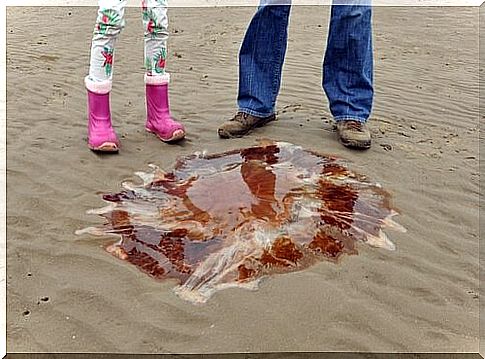Lion’s Mane: The Largest Jellyfish In The World

The lion’s mane is the largest jellyfish that exists. This huge invertebrate lives deep in the ocean, but when it gets close to shore, it can wreak havoc, though it’s not deadly toxic. Find out all about this giant below.
Lion’s Mane Characteristics
The lion’s mane is the largest known jellyfish. The largest specimen ever seen was over two meters in diameter and had tentacles nearly 37 meters in length.
However, they are usually not that big. Those moving southward and reaching the coast usually measure no more than 50 centimeters in diameter, and the tentacles reach no more than 30 meters in length. However, the size of these jellyfish varies according to the area in which they grow and develop.
As with all jellyfish, in the body of the lion’s mane we can distinguish between the umbrella (body) and the tentacles. The body is formed by eight clusters, from which between 70 and 100 tentacles appear. Around the body, there is an organ that helps them orient themselves so they know where to swim.
The tentacles of this animal are too sticky for them to capture prey. In the tentacles, there are thousands of stinging cells that paralyze the fish that get tangled up between them ; in this way, the lion’s mane gets virtually all the food it needs.

In terms of colors, the lion’s mane has a great variety: it appears that the larger each specimen is, the darker its color. Thus, the smaller specimens are almost transparent; medium-sized adults are yellow to orange in color, while giant specimens are red to purple in color.
Habitat
The lion’s mane lives in the coldest waters of the northern hemisphere: they are distributed mainly in Arctic waters, although they can also be found in the Pacific and Atlantic oceans. Those found in the Arctic are generally larger than those moving southward.
Therefore, the areas in which they usually appear are close to Scandinavia or Greenland. However, they are increasingly being seen towards the south. It is assumed that, as they are not great swimmers, they are dragged by the sea currents: they are appearing more and more off the coast of the United Kingdom and France.
They are animals from the depths, which live below 3,000 meters deep, where there is no light and the pressure is much greater. They are not able to live on the surface, and when they approach the coast, they are either sick or already dead.
toxicity
The lion’s mane has its thousands of tentacles impregnated with poison, with which it paralyzes the fish that get tangled up in them in order to eat them. However, its venom is not deadly to humans.

However, there have already been cases of lion’s mane jellyfish that reached the coast and poisoned human beings. The symptoms caused are very painful, but not fatal: itching, burning and irritation of the skin.
The jellyfish that reach the coast are usually already almost decomposed corpses, which take bathers by surprise. There are so many tentacles and they are so long that when there is an accident like that, there can be up to 100 people affected.
Lion’s Mane Feed
Lion’s mane jellyfish are predators but not active. One of your techniques is to wait for your fangs to become entangled in your tentacles, where the venom stuns them so they can bring them closer to your mouth.
Therefore, she is not selective with her diet: she feeds on all the fish or jellyfish she finds. However, other living beings can live between its tentacles, such as shrimp, for example, which are not affected by the poison and, thus, establish a symbiotic relationship. In addition, it also feeds on plankton.
The lion’s mane jellyfish is considered the longest animal on the planet, even longer than the humpback whale. Fortunately for bathers, although not deadly, it is an abyssal animal that lives in the depths and only rarely appears on the surface.








